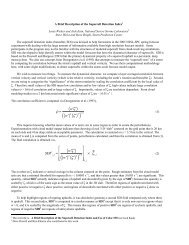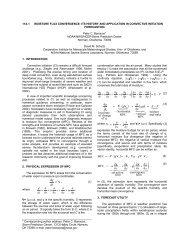Examination of WSR-88D VWP Data in Proximity to Strong Tornadoes
Examination of WSR-88D VWP Data in Proximity to Strong Tornadoes
Examination of WSR-88D VWP Data in Proximity to Strong Tornadoes
You also want an ePaper? Increase the reach of your titles
YUMPU automatically turns print PDFs into web optimized ePapers that Google loves.
P4.62 EXAMINATION OF <strong>WSR</strong>-<strong>88D</strong> <strong>VWP</strong> DATA IN PROXIMITY TO STRONG TORNADOES<br />
Jared L. Guyer * and John A. Hart<br />
NOAA/NWS S<strong>to</strong>rm Prediction Center, Norman, Oklahoma<br />
1. INTRODUCTION<br />
Among other fac<strong>to</strong>rs, it is well-established<br />
that <strong>in</strong>fluences <strong>of</strong> at least sufficiently strong shear and<br />
s<strong>to</strong>rm relative helicity (SRH) with<strong>in</strong> the lowest few km<br />
AGL are key <strong>in</strong>gredients with respect <strong>to</strong> supercells<br />
that tend <strong>to</strong> produce <strong>to</strong>rnadoes. Observationally<br />
moni<strong>to</strong>r<strong>in</strong>g and evaluat<strong>in</strong>g temporal trends and<br />
relatively f<strong>in</strong>e-scale changes <strong>of</strong> low-level shear and<br />
SRH are critically important <strong>to</strong> operational forecasters<br />
at the S<strong>to</strong>rm Prediction Center (SPC) and other<br />
National Weather Service (NWS) <strong>of</strong>fices.<br />
One method for moni<strong>to</strong>r<strong>in</strong>g such low-level<br />
w<strong>in</strong>d changes can be done through means such as<br />
the Weather Surveillance Radar-1988 Doppler (<strong>WSR</strong>-<br />
<strong>88D</strong>) network derived velocity azimuth display (VAD)<br />
w<strong>in</strong>d pr<strong>of</strong>ile (<strong>VWP</strong>). <strong>VWP</strong> data from <strong>WSR</strong>-<strong>88D</strong>s <strong>of</strong>fer<br />
much greater temporal and spatial observational<br />
density as compared <strong>to</strong> observed raw<strong>in</strong>sondes<br />
(typically only twice a day) and w<strong>in</strong>d pr<strong>of</strong>ilers (ma<strong>in</strong>ly<br />
central United States and recently decreas<strong>in</strong>g <strong>in</strong><br />
number). W<strong>in</strong>d <strong>in</strong>formation is processed by the <strong>WSR</strong>-<br />
<strong>88D</strong> VAD algorithm and if sufficient data reliability<br />
exists (symmetry and lack <strong>of</strong> statistical error), the<br />
<strong>VWP</strong> displays areal-averaged horizontal w<strong>in</strong>ds on a<br />
time versus height basis for each radar volume scan<br />
when sufficient scatterers are available (Klazura and<br />
Imy 1993). Stensrud et al. (1990) found VAD w<strong>in</strong>d<br />
data <strong>to</strong> be comparable <strong>to</strong> a digital sound<strong>in</strong>g system<br />
except when w<strong>in</strong>ds were weak. A number <strong>of</strong> other<br />
studies have discussed possible <strong>VWP</strong> biases and<br />
contam<strong>in</strong>ation issues from migra<strong>to</strong>ry birds and fronts<br />
(e.g. Niziol 1998; Gauthreaux et al. 1998) along with<br />
other potential errors and discrepancies (Nelson et al.<br />
1995). While <strong>VWP</strong> data may be subject <strong>to</strong> reliability<br />
uncerta<strong>in</strong>ty and associated caveats (as any dataset),<br />
available <strong>VWP</strong> data (for which sufficient scatterers<br />
existed) were used <strong>in</strong> this study on an as-is basis,<br />
especially given its operational availability and,<br />
<strong>of</strong>tentimes, lack <strong>of</strong> pseudo real-time alternatives.<br />
A number <strong>of</strong> past studies have used<br />
proximity raw<strong>in</strong>sonde data (Davies and Johns 1993;<br />
Craven and Brooks 2004) and model-based (e.g.,<br />
RUC; Thompson et al. 2003) <strong>in</strong>formation <strong>to</strong> estimate<br />
supercell <strong>to</strong>rnado environments, but relatively fewer<br />
aggregate <strong>to</strong>rnado studies have utilized <strong>WSR</strong>-<strong>88D</strong><br />
<strong>VWP</strong> <strong>in</strong>formation <strong>to</strong> evaluate vertical w<strong>in</strong>d shear<br />
associated with <strong>to</strong>rnadoes. Medl<strong>in</strong> and Bunkers<br />
(2008) exam<strong>in</strong>ed the w<strong>in</strong>d shear characteristics prior<br />
<strong>to</strong> <strong>to</strong>rnadoes along the north-central Gulf Coast us<strong>in</strong>g<br />
<strong>WSR</strong>-<strong>88D</strong> <strong>VWP</strong> data from a s<strong>in</strong>gular radar (KMOB).<br />
In this study, a multi-year (2008-2011) <strong>WSR</strong>-<br />
<strong>88D</strong> <strong>VWP</strong> dataset was used <strong>to</strong> exam<strong>in</strong>e the<br />
magnitude and temporal trends <strong>of</strong> low-level shear and<br />
SRH associated with strong <strong>to</strong>rnado environments.<br />
Of particular focus are observed supercells that<br />
produced strong <strong>to</strong>rnadoes (def<strong>in</strong>ed here as EF3 and<br />
greater) with<strong>in</strong> close proximity (≤75 km) <strong>of</strong> a<br />
contiguous United States (CONUS) <strong>WSR</strong>-<strong>88D</strong> site.<br />
This <strong>WSR</strong>-<strong>88D</strong> <strong>VWP</strong>-based analysis provides<br />
additional observationally-based exam<strong>in</strong>ation <strong>of</strong> the<br />
low-level w<strong>in</strong>d pr<strong>of</strong>iles associated with the near-s<strong>to</strong>rm<br />
environments <strong>of</strong> strong <strong>to</strong>rnadoes.<br />
2. DATA COLLECTION AND METHODOLOGY<br />
With a study emphasis on strong and violent<br />
<strong>to</strong>rnadoes <strong>in</strong> close proximity <strong>to</strong> CONUS <strong>WSR</strong>-<strong>88D</strong><br />
locations, <strong>to</strong>rnado statistics for EF3-EF5 <strong>to</strong>rnadoes<br />
were utilized from the S<strong>to</strong>rm <strong>Data</strong>-derived ONETOR<br />
database from parts <strong>of</strong> a four-year period (May 2008-<br />
December 2011). The <strong>to</strong>rnado database was filtered<br />
<strong>to</strong> those EF3+ <strong>to</strong>rnadoes that occurred ≤75 km from<br />
any CONUS <strong>WSR</strong>-<strong>88D</strong> location at any po<strong>in</strong>t <strong>of</strong> the<br />
<strong>to</strong>rnado track path for the period <strong>of</strong> study. Upon<br />
evaluation <strong>of</strong> archive level II volumetric Doppler radar<br />
data (<strong>in</strong> a manner similar <strong>to</strong> Smith et al. 2012), only<br />
<strong>to</strong>rnado tracks associated with discrete, semidiscrete,<br />
or clusters <strong>of</strong> supercells were utilized, with a<br />
relatively small number (7 cases) <strong>of</strong> squall l<strong>in</strong>e and<br />
QLCS related <strong>to</strong>rnadoes excluded.<br />
For this study, observed w<strong>in</strong>d pr<strong>of</strong>iles for 0-6<br />
hours prior <strong>to</strong> <strong>to</strong>rnado occurrence were derived from<br />
an archive <strong>of</strong> <strong>WSR</strong>-<strong>88D</strong> <strong>VWP</strong> data. <strong>Proximity</strong> surface<br />
w<strong>in</strong>d observations (ASOS/AWOS) with<strong>in</strong> the<br />
uncontam<strong>in</strong>ated <strong>in</strong>flow side <strong>of</strong> the s<strong>to</strong>rm were used <strong>to</strong><br />
augment the lowest level <strong>of</strong> the observed <strong>WSR</strong>-<strong>88D</strong><br />
<strong>VWP</strong> data, typically from a time 0-0.5 hour prior <strong>to</strong><br />
<strong>to</strong>rnado onset. Radar observed s<strong>to</strong>rm motions were<br />
utilized for SRH calculations. Ultimately, time-height<br />
series <strong>of</strong> <strong>VWP</strong> data and associated vertical shear<br />
calculations were constructed for each <strong>to</strong>rnado event,<br />
such as <strong>in</strong> Fig. 1 for 10 May 2010 <strong>in</strong> central<br />
Oklahoma.<br />
* Correspond<strong>in</strong>g author address: Jared L. Guyer<br />
NOAA/NWS S<strong>to</strong>rm Prediction Center, National Weather<br />
Center, 120 David L. Boren Blvd, Suite 2300, Norman, OK<br />
73072; e-mail: Jared.Guyer@noaa.gov
3. TORNADO DATASET<br />
Figure 1. Hodograph and time-height display (6-hr<br />
trend with most recent data on left side) from KTLX<br />
(Oklahoma City/Tw<strong>in</strong> Lakes) <strong>VWP</strong> end<strong>in</strong>g at 2210<br />
UTC 10 May, 2010. Approximate <strong>to</strong>rnado time<br />
denoted by a red T. Increase <strong>in</strong> low-level SRH<br />
highlighted by blue rectangles. Observed s<strong>to</strong>rm<br />
motion used for SRH calculations.<br />
48 Total<br />
<strong>Tornadoes</strong><br />
EF-Scale<br />
# <strong>Tornadoes</strong><br />
EF3 29<br />
EF4 16<br />
EF5 3<br />
Table 1. <strong>Tornadoes</strong> <strong>in</strong>cluded <strong>in</strong> this study by EF-Scale.<br />
Out <strong>of</strong> 182 CONUS EF3+ <strong>to</strong>rnado tracks<br />
(May 2008-December 2011), a <strong>to</strong>tal <strong>of</strong> 48 EF3+<br />
<strong>to</strong>rnadoes (Table 1) were found <strong>to</strong> satisfy the ≤75 km<br />
<strong>WSR</strong>-<strong>88D</strong> proximity criteria for which Level II radar<br />
data was available. These 48 <strong>to</strong>rnadoes occurred on<br />
18 separate convective days (i.e., 12 UTC - 12 UTC)<br />
<strong>in</strong> parts <strong>of</strong> the Great Pla<strong>in</strong>s, southeast United States,<br />
and Midwest (Fig. 2). It should be noted that the<br />
cases are dom<strong>in</strong>ated by several significant <strong>to</strong>rnado<br />
days <strong>in</strong>clud<strong>in</strong>g prolific outbreaks on 24 May 2011, 16<br />
April 2011, and especially 27 April 2011 (15 <strong>of</strong> 48<br />
events; Table 2). The <strong>to</strong>rnado dataset was largely<br />
comprised (96%) <strong>of</strong> spr<strong>in</strong>gtime events (April <strong>to</strong> mid-<br />
June), with only two cool season cases (one each <strong>in</strong><br />
November and January). Regard<strong>in</strong>g the time <strong>of</strong> day,<br />
<strong>to</strong>rnado onset times spanned from 17:19 UTC <strong>to</strong> 4:53<br />
UTC, although most occurred <strong>in</strong> the mid/late<br />
afternoon and early/mid even<strong>in</strong>g hours (83% between<br />
20 UTC and 04 UTC).<br />
Date<br />
<strong>WSR</strong>-<strong>88D</strong> Location<br />
5/23/08 KDDC<br />
6/03/08 KIND<br />
6/11/08 KTWX KOAX<br />
4/09/09 KSHV<br />
4/10/09 KOHX KHTX<br />
1/20/10 KSHV<br />
4/24/10 KHTX(2) KBMX<br />
5/10/10 KTLX(4) KVNX<br />
6/05/10 KLOT<br />
6/17/10 KMVX<br />
4/15/11 KMOB KBMX<br />
4/16/11 KRAX(2) KAKQ KMHX<br />
4/22/11 KLSX<br />
4/27/11 KHTX(4) KGWX(4) KBMX(3) KMRX(2) KFFC(2)<br />
5/21/11 KTWX<br />
5/24/11 KTLX(3) KSRX KVNX<br />
5/26/11 KLIX<br />
11/7/11 KFDR<br />
Table 2. <strong>WSR</strong>-<strong>88D</strong> locations used by identifier<br />
(accompany<strong>in</strong>g numbers represent number <strong>of</strong><br />
<strong>to</strong>rnadoes if more than one) by convective day (12<br />
UTC) for <strong>to</strong>rnadoes (EF3-EF5) exam<strong>in</strong>ed <strong>in</strong> this study.<br />
4. ANALYSIS<br />
Figure 2. Map <strong>of</strong> EF3-EF5 <strong>to</strong>rnado tracks (2008-<br />
2011) ≤75 km <strong>of</strong> NEXRAD <strong>WSR</strong>-<strong>88D</strong> radar site. EF3<br />
<strong>to</strong>rnado tracks <strong>in</strong> blue, EF4 <strong>to</strong>rnadoes <strong>in</strong> black, and<br />
EF5 <strong>to</strong>rnadoes <strong>in</strong> red. <strong>WSR</strong>-<strong>88D</strong> radar locations<br />
noted by yellow circles.<br />
Not surpris<strong>in</strong>gly, <strong>WSR</strong>-<strong>88D</strong> <strong>VWP</strong> derived<br />
hodographs for the EF3+ <strong>to</strong>rnado events typically<br />
exhibited an elongated clockwise-curv<strong>in</strong>g low-level<br />
hodograph character. Resultant very strong low-level<br />
shear and SRH are consistent with prior studies <strong>of</strong><br />
strong <strong>to</strong> violent <strong>to</strong>rnado environments (Thompson et<br />
al. 2003; Cohen 2010). In this study, mean bulk<br />
shear magnitude for 0-0.5 km, 0-1 km, and 0-3 km<br />
AGL were 25 kt, 36 kt, and 54 kt, respectively (Fig. 3).
Mean SRH values for 0-0.5 km, 0-1 km, and 0-3 km<br />
AGL were 216 m 2 /s 2 , 341 m 2 /s 2 and 502 m 2 /s 2 ,<br />
respectively (Fig. 4). Given these values, the ratio for<br />
0-1 km mean SRH vs. 0-3 km mean SRH was found<br />
<strong>to</strong> be 69%, which is <strong>in</strong>dicative <strong>of</strong> a relatively high<br />
near-ground concentration <strong>of</strong> SRH for EF3+<br />
<strong>to</strong>rnadoes. These f<strong>in</strong>d<strong>in</strong>gs are relatively similar <strong>to</strong><br />
Cohen 2010 (albeit EF4+ <strong>to</strong>rnadoes vs. EF3+<br />
<strong>to</strong>rnadoes <strong>in</strong> this study). In fact, our f<strong>in</strong>d<strong>in</strong>gs show<br />
that the lowest 0.5 km layer AGL accounted for 64%<br />
<strong>of</strong> 0-1 km SRH and 45% <strong>of</strong> 0-3 km SRH on average<br />
for EF3+ <strong>to</strong>rnadoes (Fig. 5). In terms <strong>of</strong> bulk shear<br />
magnitude, the 0-0.5 km layer AGL bulk shear was<br />
69% <strong>of</strong> the 0-1 km mean bulk shear magnitude and<br />
46% <strong>of</strong> the 0-3 km mean bulk shear magnitude (not<br />
shown).<br />
900<br />
800<br />
700<br />
600<br />
500<br />
400<br />
300<br />
200<br />
100<br />
0<br />
<strong>VWP</strong> SRH for EF3+ <strong>Tornadoes</strong><br />
849<br />
724<br />
597<br />
484<br />
502<br />
384<br />
314<br />
341<br />
248<br />
216<br />
177<br />
181<br />
110<br />
113<br />
82<br />
0-0.5 km 0-1 km 0-3 km<br />
70<br />
60<br />
50<br />
40<br />
30<br />
20<br />
10<br />
0<br />
<strong>VWP</strong> Bulk Shear for EF3+ <strong>Tornadoes</strong><br />
35<br />
30<br />
25<br />
20<br />
17<br />
47<br />
43<br />
36<br />
30<br />
25<br />
0-0.5 km 0-1 km 0-3 km<br />
66<br />
62<br />
Figure 3. Box and whisker diagrams <strong>of</strong> low-level (0-<br />
0.5, 0-1, & 0-3 km AGL) bulk shear (kt) for EF3+<br />
<strong>to</strong>rnadoes ≤75 km <strong>of</strong> <strong>WSR</strong>-<strong>88D</strong> <strong>VWP</strong> for 2008-2011.<br />
Each box is representative <strong>of</strong> the 25 th <strong>to</strong> 75 th<br />
percentiles <strong>of</strong> values with the mean value <strong>in</strong> the<br />
middle. The outer whiskers represent the 10 th and<br />
90 th percentiles.<br />
Additionally, relatively short-term temporal<br />
trends <strong>of</strong> low-level bulk shear and SRH preced<strong>in</strong>g<br />
<strong>to</strong>rnado development were exam<strong>in</strong>ed. It was found<br />
that 0-0.5 km and 0-1 km SRH <strong>in</strong>creased (at least<br />
modestly) over the preced<strong>in</strong>g 1-2 hours prior <strong>to</strong><br />
<strong>to</strong>rnado development <strong>in</strong> 47% <strong>of</strong> cases, while<br />
<strong>in</strong>creases <strong>in</strong> 0-0.5 km and 0-1 km bulk shear<br />
magnitude occurred <strong>in</strong> 61% <strong>of</strong> cases (such as Fig. 1<br />
<strong>in</strong> both regards). Even though the overall magnitudes<br />
were typically very strong, short-term <strong>in</strong>creas<strong>in</strong>g<br />
trends were less evident with<strong>in</strong> the 0-3 km layer (e.g.<br />
0-3 km bulk shear <strong>in</strong>creased <strong>in</strong> the <strong>to</strong>rnado-preced<strong>in</strong>g<br />
1-2 hours only 42% <strong>of</strong> the time).<br />
Prior studies such as Thompson and<br />
Edwards (2000) and Miller (2006) discussed low-level<br />
hodograph characteristics <strong>of</strong> strong <strong>to</strong>rnadoes<br />
<strong>in</strong>clud<strong>in</strong>g an observationally prom<strong>in</strong>ent low-level (1-<br />
1.5 km and below) “sickle” shape. Esterheld and<br />
54<br />
47<br />
38<br />
Figure 4. Same as Fig. 3, except 0-0.5 km SRH, 0-1<br />
km SRH, and 0-3 km SRH (m 2 /s 2 ).<br />
90%<br />
80%<br />
70%<br />
60%<br />
50%<br />
40%<br />
30%<br />
20%<br />
Ratio <strong>of</strong> SRH for EF3+ <strong>Tornadoes</strong><br />
66%<br />
51%<br />
45%<br />
35%<br />
30%<br />
78%<br />
70%<br />
64%<br />
58%<br />
50%<br />
83%<br />
73%<br />
69%<br />
60%<br />
56%<br />
0.5 km/3 km 0.5 km/1 km 1 km/3 km<br />
Figure 5. Same as Fig. 3, except ratio <strong>of</strong> 0-0.5 km<br />
SRH <strong>to</strong> 0-3 km SRH, 0-0.5 km SRH <strong>to</strong> 0-1 km SRH,<br />
and 0-1 km SRH <strong>to</strong> 0-3 km SRH (m 2 /s 2 ).<br />
Guiliano (2008) exam<strong>in</strong>ed this hodograph k<strong>in</strong>k <strong>in</strong><br />
greater detail for <strong>to</strong>rnado cases <strong>in</strong> Oklahoma. They<br />
found that the “critical angle” (def<strong>in</strong>ed as the angle<br />
between the s<strong>to</strong>rm-relative <strong>in</strong>flow vec<strong>to</strong>r at 10 m and<br />
the 10-500 m AGL shear vec<strong>to</strong>r) tended <strong>to</strong> be near 90<br />
degrees, particularly for supercell that produced<br />
(E)F2+ <strong>to</strong>rnadoes. Relatively similar <strong>to</strong> the f<strong>in</strong>d<strong>in</strong>gs <strong>of</strong><br />
Esterheld and Guiliano (2008), our more spatially<br />
diverse study found that the median critical angle <strong>to</strong><br />
be 79 degrees with the <strong>in</strong>terquartile critical angle<br />
values rang<strong>in</strong>g from 63 <strong>to</strong> 88 degrees (Fig. 6). Our<br />
prelim<strong>in</strong>ary case analysis reflected a greater tendency<br />
for near-90 degree angles strong <strong>to</strong>rnado cases <strong>in</strong> the<br />
Pla<strong>in</strong>s, while a number <strong>of</strong> strong or violent <strong>to</strong>rnadoes<br />
<strong>in</strong> the southeast U.S. (such as 27 April 2011)<br />
occurred <strong>in</strong> association with a critical angle far less<br />
than 90 degrees (e.g., ~55-60 degrees <strong>in</strong> some<br />
cases).
100<br />
90<br />
80<br />
70<br />
60<br />
50<br />
40<br />
Critical Angle for EF3+ <strong>Tornadoes</strong><br />
Figure 6. Same as Fig. 3, except Critical Angle <strong>in</strong><br />
degrees (Esterheld and Giuliano 2008).<br />
5. COMPARISON TO SPC ENVIRONMENT<br />
DATABASE<br />
As a supplement <strong>to</strong> direct observational<br />
data, an objective analysis (SFCOA) based on a<br />
blend <strong>of</strong> surface METAR observations and RUC (now<br />
RAP) analysis fields (Bothwell et al. 2002) is heavily<br />
utilized by S<strong>to</strong>rm Prediction Center (SPC) forecasters<br />
and NWS field personnel for moni<strong>to</strong>r<strong>in</strong>g<br />
environmental changes on an hourly basis. As such,<br />
a comparison <strong>of</strong> the <strong>VWP</strong> data <strong>to</strong> SFCOA was an<br />
appropriate step <strong>to</strong> <strong>in</strong>vestigate potential differences<br />
that may be evident between these datasets.<br />
Accord<strong>in</strong>gly, comparisons were made <strong>to</strong> estimated<br />
<strong>to</strong>rnado environment <strong>in</strong>formation from a gridded SPC<br />
database as described by Dean et al. (2006). With<strong>in</strong><br />
this database, severe s<strong>to</strong>rm reports are objectively<br />
l<strong>in</strong>ked <strong>to</strong> estimated environments as derived from<br />
hourly SFCOA grids (40 km grid length). Specific<br />
environmental parameters (e.g., 0-1 SRH, etc.) were<br />
objectively derived from the 40 km grid box <strong>in</strong> which<br />
each EF3+ <strong>to</strong>rnado event occurred.<br />
In aggregate for the 48 EF3+ <strong>to</strong>rnado cases,<br />
our prelim<strong>in</strong>ary f<strong>in</strong>d<strong>in</strong>gs were that <strong>WSR</strong>-<strong>88D</strong> derived<br />
0-1 km bulk shear (Fig. 7) and 0-1 km SRH (Fig. 8)<br />
tended <strong>to</strong> be slightly lower (63% <strong>of</strong> the time) as<br />
compared <strong>to</strong> the gridded SFCOA data. The mean<br />
absolute difference was 7 kt for 0-1 km bulk shear<br />
magnitude and 187 m 2 /s 2 for 0-1 km SRH. However,<br />
it is important <strong>to</strong> note that case-<strong>to</strong>-case variability was<br />
considerable when compar<strong>in</strong>g <strong>WSR</strong>-<strong>88D</strong> <strong>VWP</strong> data<br />
and the SFCOA. In 27% <strong>of</strong> the EF3+ <strong>to</strong>rnado cases,<br />
<strong>WSR</strong>-<strong>88D</strong> <strong>VWP</strong> derived 0-1 km shear magnitude was<br />
found <strong>to</strong> vary by more than 10 kt from SFCOA (<strong>WSR</strong>-<br />
<strong>88D</strong> <strong>VWP</strong> was lower for 62% <strong>of</strong> these cases). In 54%<br />
<strong>of</strong> the <strong>to</strong>rnado cases, <strong>WSR</strong>-<strong>88D</strong> <strong>VWP</strong> derived 0-1 km<br />
SRH was found <strong>to</strong> vary by more than 150 m 2 /s 2 from<br />
SFCOA (<strong>WSR</strong>-<strong>88D</strong> <strong>VWP</strong> was lower for 77%). Aside<br />
from s<strong>to</strong>rm motion <strong>in</strong>consistencies (forecast vs.<br />
observed) between the datasets for calculat<strong>in</strong>g SRH,<br />
some <strong>of</strong> the differences may also be attributable <strong>to</strong><br />
the gridded nature <strong>of</strong> the SFCOA comparative<br />
dataset. Regardless, such differences stress the<br />
critical case-by-case importance <strong>of</strong> observational<br />
97<br />
88<br />
77<br />
63<br />
55<br />
based moni<strong>to</strong>r<strong>in</strong>g <strong>of</strong> near-s<strong>to</strong>rm environment<br />
<strong>in</strong>formation and evaluation <strong>of</strong> s<strong>to</strong>rm motion by<br />
operational forecasters.<br />
60<br />
50<br />
40<br />
30<br />
20<br />
<strong>WSR</strong>-<strong>88D</strong> <strong>VWP</strong><br />
53<br />
47<br />
48<br />
43<br />
39<br />
36<br />
30<br />
29<br />
25 25<br />
Figure 7. Same as Fig. 3, except a comparison <strong>of</strong> 0-1<br />
km bulk shear (km) for <strong>WSR</strong>-<strong>88D</strong> <strong>VWP</strong> vs. SPC<br />
objective mesoanalysis (SFCOA).<br />
800<br />
700<br />
600<br />
500<br />
400<br />
300<br />
200<br />
100<br />
0<br />
0-1 km Bulk Shear for EF3+ <strong>Tornadoes</strong><br />
597<br />
341<br />
177<br />
113<br />
Figure 8. Same as Fig. 3, except a comparison <strong>of</strong> 0-1<br />
km SRH (m 2 /s 2 ) for <strong>WSR</strong>-<strong>88D</strong> <strong>VWP</strong> vs. SPC objective<br />
mesoanalysis (SFCOA).<br />
6. SUMMARY AND FUTURE WORK<br />
SFCOA<br />
0-1 km SRH for EF3+ <strong>Tornadoes</strong><br />
484<br />
<strong>WSR</strong>-<strong>88D</strong> <strong>VWP</strong><br />
SFCOA<br />
675<br />
539<br />
438<br />
344<br />
199<br />
This study exam<strong>in</strong>ed low-level shear<br />
calculated from <strong>WSR</strong>-<strong>88D</strong> <strong>VWP</strong> data associated with<br />
48 EF3+ <strong>to</strong>rnadoes that occurred <strong>in</strong> close spatial<br />
proximity <strong>to</strong> CONUS <strong>WSR</strong>-<strong>88D</strong> sites. Compared <strong>to</strong><br />
the relative prevalence <strong>of</strong> prior studies us<strong>in</strong>g platforms<br />
such as observed raw<strong>in</strong>sonde data, pr<strong>of</strong>iler network,<br />
and/or numerical models (e.g. RUC), <strong>WSR</strong>-<strong>88D</strong> <strong>VWP</strong><br />
data may be an underutilized resource, especially<br />
given its spatiotemporal availability and operational<br />
utility <strong>in</strong> severe local s<strong>to</strong>rm environments. This<br />
prelim<strong>in</strong>ary study found that <strong>WSR</strong>-<strong>88D</strong> <strong>VWP</strong>-derived<br />
values <strong>of</strong> low-level shear and SRH were very large<br />
(e.g., mean 0-1 km SRH <strong>of</strong> 341 m 2 /s 2 ) <strong>in</strong> association<br />
with EF3+ <strong>to</strong>rnadoes, with a trend <strong>to</strong>ward <strong>in</strong>creas<strong>in</strong>g<br />
low-level shear/SRH with<strong>in</strong> the 0-0.5 km and 0-1 km<br />
layers <strong>in</strong> roughly half <strong>of</strong> the cases dur<strong>in</strong>g the 1-2<br />
hours prior <strong>to</strong> <strong>to</strong>rnado onset.
It should aga<strong>in</strong> be acknowledged that these<br />
prelim<strong>in</strong>ary results and conclusions are derived from a<br />
relatively limited dataset <strong>of</strong> <strong>to</strong>rnado events that are<br />
dom<strong>in</strong>ated by several high-end outbreak days. Future<br />
work will <strong>in</strong>clude the addition <strong>of</strong> EF1 and EF2 <strong>to</strong>rnado<br />
cases ≤75 km <strong>of</strong> a CONUS <strong>WSR</strong>-<strong>88D</strong>, along with<br />
more comprehensive exam<strong>in</strong>ations <strong>of</strong> the f<strong>in</strong>e-scale<br />
variability and pre-s<strong>to</strong>rm low-level w<strong>in</strong>d shear trends<br />
for supercells associated with strong <strong>to</strong> violent<br />
<strong>to</strong>rnadoes. Comparisons and sensitivity tests will also<br />
be made <strong>to</strong> observed raw<strong>in</strong>sonde and w<strong>in</strong>d pr<strong>of</strong>iler<br />
network data.<br />
Acknowledgements. The authors would like <strong>to</strong> thank<br />
Israel Jirak (SPC) for his review <strong>of</strong> this manuscript.<br />
Matt Mosier (SPC) is also acknowledged for his script<br />
assistance <strong>in</strong> gather<strong>in</strong>g surface observation data.<br />
7. REFERENCES<br />
Bothwell, P. D., J. A. Hart, and R. L. Thompson, 2002:<br />
An <strong>in</strong>tegrated three-dimensional objective analysis<br />
scheme <strong>in</strong> use at the S<strong>to</strong>rm Prediction Center.<br />
Prepr<strong>in</strong>ts, 21st Conf. on Severe Local S<strong>to</strong>rms, San<br />
An<strong>to</strong>nio, TX, Amer. Meteor. Soc., J117–J120.<br />
Cohen, A. E., 2010: Indices <strong>of</strong> violent <strong>to</strong>rnado<br />
environments. Electronic J. Operational Meteor., 11<br />
(6), 1-24.<br />
Craven, J. P., and H. E. Brooks, 2004: Basel<strong>in</strong>e<br />
clima<strong>to</strong>logy <strong>of</strong> sound<strong>in</strong>g derived parameters<br />
associated with deep moist convection. Natl. Wea.<br />
Dig., 28, 13-24.<br />
Davies, J. M., and R. H. Johns, 1993: Some w<strong>in</strong>d and<br />
<strong>in</strong>stability parameters associated with strong and<br />
violent <strong>to</strong>rnadoes. 1. W<strong>in</strong>d shear and helicity. The<br />
Tornado: Its Structure, Dynamics, Prediction, and<br />
Hazards, Geophys. Monogr., No. 79, Amer. Geophys.<br />
Union, 573–582.<br />
Dean, A.R., R.S. Schneider, and J.T. Schaefer, 2006:<br />
Development <strong>of</strong> a Comprehensive Severe Weather<br />
Forecast Verification System at the S<strong>to</strong>rm Prediction<br />
Center. Prepr<strong>in</strong>ts, 23nd Conf. Severe Local S<strong>to</strong>rms,<br />
St. Louis MO.<br />
Medl<strong>in</strong>, J.M., and M. Bunkers, 2008: An <strong>Exam<strong>in</strong>ation</strong><br />
<strong>of</strong> North Central Gulf Coast Cold Season Pre-<br />
Tornadic Vertical W<strong>in</strong>d Shear Environments s<strong>in</strong>ce<br />
1996. Presented at 33rd National Weather<br />
Association Annual Meet<strong>in</strong>g, Louisville, KY.<br />
Miller, D. J., 2006: Observations <strong>of</strong> low level<br />
thermodynamic and w<strong>in</strong>d shear pr<strong>of</strong>iles on significant<br />
<strong>to</strong>rnado days. Prepr<strong>in</strong>ts, 23rd Conf. on Severe Local<br />
S<strong>to</strong>rms, St. Louis, MO, Amer. Meteor. Soc., 1206-<br />
1223.<br />
Nelson, S., F. Carr, and L. Ruthi, 1995:<br />
Intercomparison <strong>of</strong> horizontal velocities observed by<br />
modern w<strong>in</strong>d-f<strong>in</strong>d<strong>in</strong>g systems.. Prepr<strong>in</strong>ts, 9th<br />
Symposium on Meteorological Observations and<br />
Instrumentation, Charlotte, NC, AMS, 5 pp.<br />
Niziol, T. A., 1998: Contam<strong>in</strong>ation <strong>of</strong> <strong>WSR</strong>-<strong>88D</strong> VAD<br />
W<strong>in</strong>ds Due <strong>to</strong> Bird Migration: A Case Study. Eastern<br />
Region <strong>WSR</strong>-<strong>88D</strong> Operations Note No. 12, August,<br />
1998.<br />
Smith, B. T., R. L. Thompson, J. S. Grams, C.<br />
Broyles, H E. Brooks, 2012: Convective Modes for<br />
Significant Severe Thunders<strong>to</strong>rms <strong>in</strong> the Contiguous<br />
United States. Part I: S<strong>to</strong>rm Classification and<br />
Clima<strong>to</strong>logy. Wea. Forecast<strong>in</strong>g, 27, 1114–1135.<br />
Stensrud, D. J., M. H. Ja<strong>in</strong>, K. W. Howard, R. A.<br />
Maddox, 1990: Operational Systems for Observ<strong>in</strong>g<br />
the Lower Atmosphere: Importance <strong>of</strong> <strong>Data</strong> Sampl<strong>in</strong>g<br />
and Archival Procedures. J. Atmos. Oceanic Technol.,<br />
7, 930–937.<br />
Thompson, R. L., R. Edwards, 2000: An Overview <strong>of</strong><br />
Environmental Conditions and Forecast Implications<br />
<strong>of</strong> the 3 May 1999 Tornado Outbreak. Wea.<br />
Forecast<strong>in</strong>g, 15, 682–699.<br />
Thompson, R. L., R. Edwards, J.A. Hart, K.L. Elmore<br />
and P.M. Markowski, 2003: Close proximity<br />
sound<strong>in</strong>gs with<strong>in</strong> supercell environments obta<strong>in</strong>ed<br />
from the Rapid Update Cycle. Wea. Forecast<strong>in</strong>g, 18,<br />
1243-1261.<br />
Esterheld, J. M. and D. J. Giuliano, 2008:<br />
Discrim<strong>in</strong>at<strong>in</strong>g between <strong>to</strong>rnadic and non-<strong>to</strong>rnadic<br />
supercells: A new hodograph technique. Electronic<br />
J. Severe S<strong>to</strong>rms Meteor., 3 (2), 1-50.<br />
Gauthreaux, S. A., Jr., D. S. Miszahi, and C. G.<br />
Belser, 1998: Bird migration and bias <strong>of</strong> <strong>WSR</strong>-<strong>88D</strong><br />
w<strong>in</strong>d estimates. Wea. Forecast<strong>in</strong>g,13, 465–481.<br />
Klazura, G. E., and D. A. Imy, 1993: A description <strong>of</strong><br />
the <strong>in</strong>itial set <strong>of</strong> analysis products available from the<br />
NEXRAD <strong>WSR</strong>-<strong>88D</strong> system. Bull. Amer. Meteor.<br />
Soc., 74, 1293–1311.


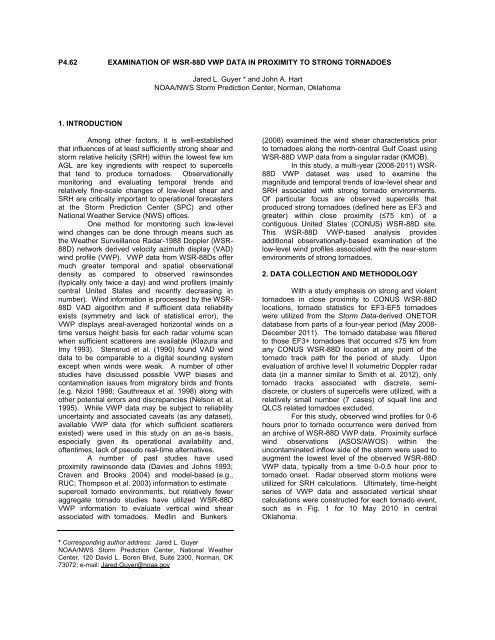
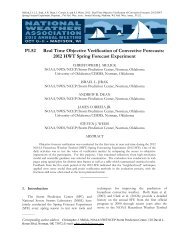
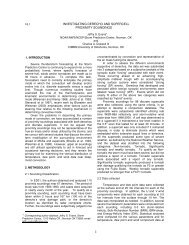
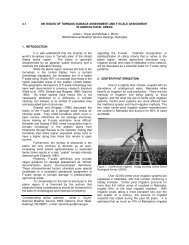
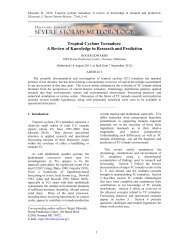


![NSWW_ROC_Overview.ppt [Read-Only] - Storm Prediction Center ...](https://img.yumpu.com/26478320/1/190x146/nsww-roc-overviewppt-read-only-storm-prediction-center-.jpg?quality=85)
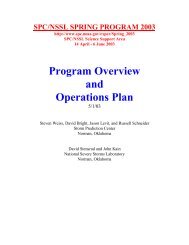
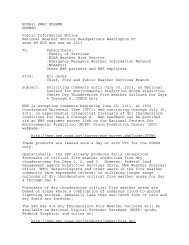
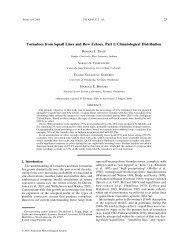

![NEW_PRODUCTS_imy.ppt [Read-Only] - Storm Prediction Center ...](https://img.yumpu.com/26478296/1/190x146/new-products-imyppt-read-only-storm-prediction-center-.jpg?quality=85)
